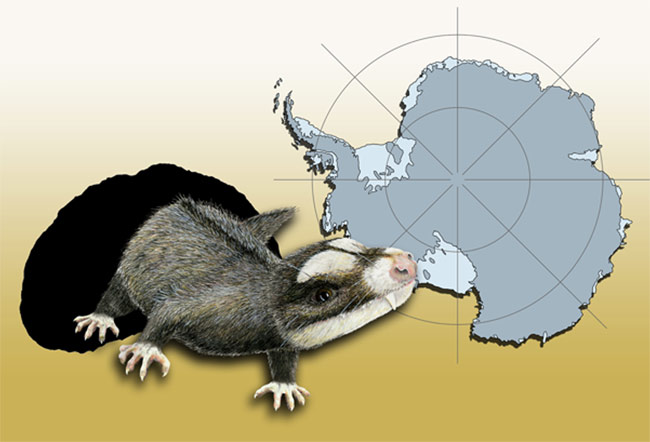New Fossils Suggest Ancient Cat-sized Reptiles in Antarctica

Cat-sized reptiles once roamed what is now the icebox of Antarctica, snuggling up in burrows and peeping above ground to snag plant roots and insects.
The evidence for this scenario comes from preserved burrow casts discovered in the Transantarctic Mountains, which extend 3,000 miles (4,800 km) across the polar continent and contain layers of rock dating back 400 million years.
"We've got good evidence that these burrows were made by land-dwelling animals rather than crayfish," said lead researcher Christian Sidor, a vertebrate paleontologist at the University of Washington and curator at UW's Burke Museum of Natural History and Culture. Ancient digging
About 245 million years ago, floodwaters likely overflowed river banks in parts of Antarctica, sending water and sand across the landscape and into various animal homes, such as burrows. No animal bones or remains were found inside the burrows, suggesting the burrow dweller must have escaped the deluge, according to study researcher Molly Miller of Vanderbilt University.
When the waters receded, the sand inside of these burrows hardened into casts. The largest burrow cast, measuring 14 inches (35 cm) long, 6 inches (16 cm) wide and 3 inches (9 cm) deep, was buried in rock layers of the Wahl Glacier dating back to about 245 million years ago during the Early Triassic period.
"The burrow is an inclined hole and at the end of the burrow the animal would scrape out a larger area and that's where it would huddle down," said Miller, a geologist.
Nine smaller burrow casts previously were discovered in the Allen Hills region in southern Victoria Land and date to the early Middle Triassic. The newly discovered casts predate fossils of tetrapods in the area, pushing back the date for such four-legged vertebrates (animals with backbones) living in Victoria Land by at least 15 million years, Sidor said.
Sign up for the Live Science daily newsletter now
Get the world’s most fascinating discoveries delivered straight to your inbox.
"This would be the earliest record of any kind of tetrapod in that part of Antarctica," Miller told LiveScience.
Burrow dwellers
None of the burrows contained animal remains. However, the burrows' sizes and shapes, along with associated scratch marks, are nearly identical to tetrapod burrows found in South Africa also dating to the Triassic.
One of these South African burrows contained a complete skeleton of an extinct mammal-like reptile called Thrinaxodon liorhinus. The larger burrow from the Wahl Glacier was likely crafted by the same type of animal, Sidor said.
The term "mammal-like reptile" is actually a little misleading. The animals belonging to this group do have a mixture of mammalian and reptilian characteristics, Sidor said, but the group is actually more closely related to mammals than to reptiles. And today's mammals are the living descendants of mammal-like reptiles, he said.
"Thrinaxodon is a distant relative of mammals," Sidor said. "It lived in the Early Triassic whereas the first mammals are Late Triassic/Early Jurassic in age. Thrinaxodon is not related to any specific type of mammals but to mammals in general."
Based on comparisons with other South African burrows, the researchers speculate the smaller burrows in Victoria Land housed mole-sized reptiles called Procolophonids.
"We have documented that tetrapods were burrowing, making dens in Antarctica, back in the Triassic," Sidor said. "There are lots of good reasons for burrowing at high latitudes, not the least of which is protection from the elements."
Different Antarctica
At the time the ancient animals presumably were excavating their subterranean homes, Antarctica would have been ice-free, with a cool temperate climate, Miller said. And Antarctica and southern Africa could have shared residents, since during the Triassic, the two regions were connected as part of the supercontinent Pangea. The Permian-Triassic extinction had just occurred, and so very few tetrapods existed at the time, with just seven tetrapod genera identified in Antarctica.
Today, no land-based animals live in Antarctica, where temperatures stay below freezing and the earth is covered in ice. (Penguins and seals of Antarctica are dependent on the sea.)
The research, supported by funding from the National Science Foundation, is detailed in the June issue of the Journal of Vertebrate Paleontology.
- Video: Under Antarctic Ice
- Rumor or Reality: The Creatures of Cryptozoology
- Amazing Animal Abilities
Jeanna Bryner is managing editor of Scientific American. Previously she was editor in chief of Live Science and, prior to that, an editor at Scholastic's Science World magazine. Bryner has an English degree from Salisbury University, a master's degree in biogeochemistry and environmental sciences from the University of Maryland and a graduate science journalism degree from New York University. She has worked as a biologist in Florida, where she monitored wetlands and did field surveys for endangered species, including the gorgeous Florida Scrub Jay. She also received an ocean sciences journalism fellowship from the Woods Hole Oceanographic Institution. She is a firm believer that science is for everyone and that just about everything can be viewed through the lens of science.









